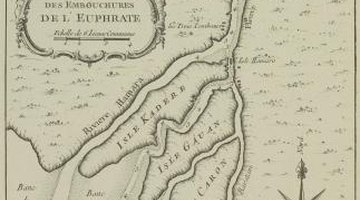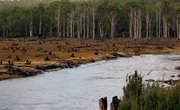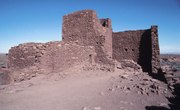The journey out of Africa for the first humans was actually several migrations spaced over tens of thousands of years as the earth's climate fluctuated dramatically and Ice Ages rose and fell. The conditions in a region dubbed the Fertile Crescent favored exploration of more geography and encouraged the development of new skills, technology and ways of relating that evolved into contemporary civilization. A fortuitous conflation of flora, fauna, fresh water and temperature made wholesale human migration possible.
First Forays
About 50,000 years ago, the Sahara had become an impassable desert, but a channel only 10 miles across separated Africa and the Arabian Peninsula. Rudimentary seafaring skills were enough to bridge the passage, and humans traveled to the coastal areas of the Middle East where they clung to the abundant profusion of shellfish and other sea harvests. Over time, they ventured into the Fertile Crescent region, some traveling northward as far as present-day Europe and others migrating eastward to southeastern and East Asia.
The Fertile Crescent reacted to a warmer, wetter climate by exploding into lush grasslands with ready water sources between the Tigris and Euphrates Rivers--Mesopotamia--and in the Nile valley. The region was an hospitable habitat for hunter-gatherers until another severe Ice Age--around 20,000 B.C.--drove them south again.
Fertile Valley
When the climate warmed and the ice melted, 15,000 to 13,000 years ago, the human migration out of Africa resumed in earnest. The Fertile Crescent was a vast, green, abundant valley, irrigated by fresh-water rivers and stocked with a variety of animals that could be domesticated.
For the first time, humans settled into rough communities and raised animals and grains for food. They no longer wandered, following seasons and herds to survive--instead they concentrated in the welcoming geography of the region, gradually deforesting the land, leaching it of nutrients and soil.
The Fertile Crescent weakened as a nurturing environment, even as it supported a sturdy and strengthening human population. The intensive farming, development of cooperative divisions of labor that encouraged the discovery of new skills and more sophisticated building and the relentless degradation of water and deforestation made the Fertile Crescent all but uninhabitable in less than a millennium.
Adaptation
The burgeoning human population spread outward, taking advantage of the stable climate conditions across the latitude to continue their farming. The animals they used were adapted to the climate and could expand into new areas and thrive, as could the crops.
Most of the domesticated animals--goats, cows, pigs, sheep and other critically-important livestock--were native to the Fertile Crescent. When people took to the road again, they traveled with their grain stores and animals, looking for hospitable settlements to resume an agrarian way of life.
Eurasia is a vast area and, as long as the nomads stopped in areas to the east and west of Mesopotamia and in the Nile delta, conditions favored the wheat, barley, pigs and goats who traveled with them. Human civilization spread rapidly to India, North Africa and Europe, where it evolved and flourished.
The Region Today
Ancient civilizations in the Fertile Crescent, Egypt, Babylonia, Phoenicia and Assyria, were the antecedents of the great empires of Greece and Rome and many of the discoveries and ideas that shaped the modern world.
Today, the region of the historic Fertile Crescent includes the nations of Egypt, Iran, Iraq, Lebanon, Syria, Turkey, Jordan, Israel and Palestine. But the main Mesopotamian valley, between the Tigris and Euphrates Rivers in Iraq and Iran, bears little resemblance to the bountiful wilderness encountered by those intrepid early humans.
The once-rich marshlands where the Tigris and Euphrates meet are mostly desert. "National Geographic" reports that only 10 percent of the viable ecosystem remains. Many native species are extinct; the rivers have been dammed and diverted for irrigation; and indigenous people, who lived in the Fertile Crescent continuously since the days of ancient Sumeria and Babylon, have been displaced.
Related Articles
References
Writer Bio
Benna Crawford has been a journalist and New York-based writer since 1997. Her work has appeared in USA Today, the San Francisco Chronicle, The New York Times, and in professional journals and trade publications. Crawford has a degree in theater, is a certified Prana Yoga instructor, and writes about fitness, performing and decorative arts, culture, sports, business and education .











